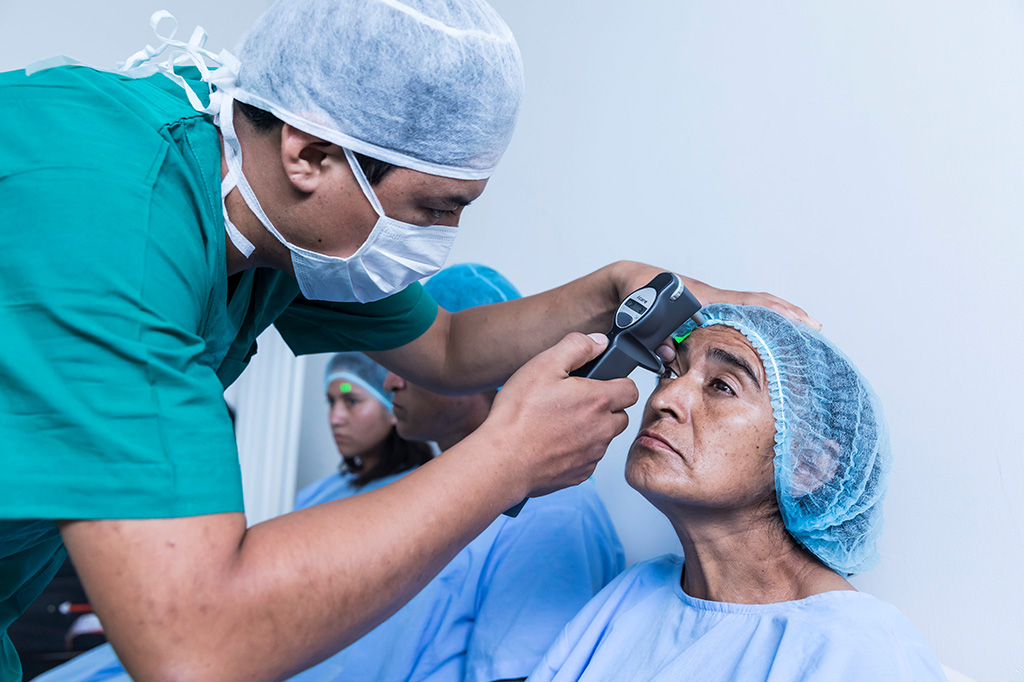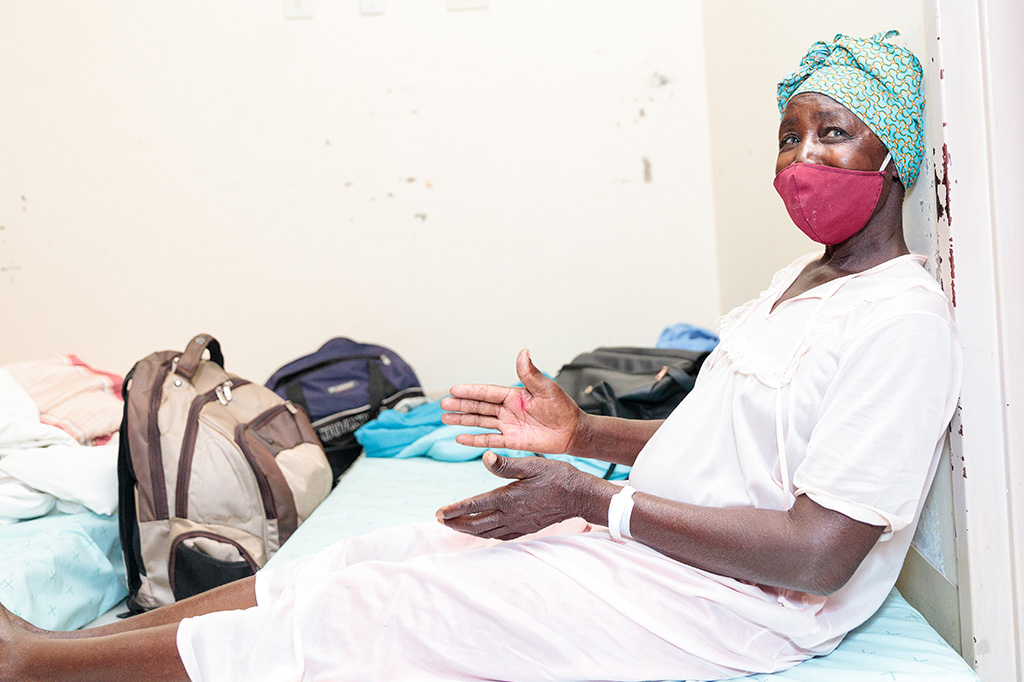Corneal Blindness
Since 1974, SEE has worked diligently around the world to reduce the number of people impacted by corneal blindness. Our network of volunteer surgeons provide free treatment to thousands of patients every year, as well as skill-sharing and training on appropriate surgical techniques to help strengthen local health care infrastructure worldwide.
What is Corneal Blindness?

What are causes of Corneal Blindness?
The cause of corneal blindness can be varied. Trachoma, corneal opacities caused by trauma, and onchocerciasis can all cause corneal blindness. The symptoms experience depend on the initial cause of corneal blindness.
(Source: Olivia, Schottman and Gulati, 2012)
Trachoma
Trachoma is a disease of the eye caused by infection with the bacteria Chlamydia trachomatis, and is responsible for the blindness of about 1.9 million people. Blindness from trachoma is irreversible.
(Source: World Health Organization, 2022)
Symptoms of trachoma infection include:
- Mild itching and irritation of the eyes and eyelids
- A discharge from the eyes
- Eye pain and blurred vision as the infection progresses
(Source: Turbent, 2022)
Early detection of trachoma
In the early stages of trachoma, treatment with antibiotics alone may be enough to eliminate the infection. Your doctor may prescribe tetracycline eye ointment or oral azithromycin. Azithromycin appears to be more effective than tetracycline, but it’s more expensive.
The World Health Organization (WHO) recommends giving antibiotics to an entire community when more than 10% of children have been affected by trachoma. The goal of this guideline is to treat anyone who has been exposed to trachoma and reduce the spread of trachoma.
Onchocerciasis
Onchocerciasis, or “river blindness”, is caused by the parasitic worm Onchocera volvulus. It is transmitted through repeated bites by blackflies of the genus Simulium.
The disease is called “river blindness” because the blackfly that transmits the infection lives and breeds near fast-flowing streams and rivers, mostly near remote rural villages. If untreated, the infection can cause visual impairment or blindness.
Persons infected with onchocerciasis may be without symptoms entirely. Those who present with symptoms usually have one or more of the following manifestations, which include:
- Skin rash (usually itchy)
- Eye disease leading to corneal blindness
- Nodules under the skin
After a blackfly bite, it can take 12-18 months for the larvae to develop into mature adult worms inside the human body that are capable of mating and producing new larvae. As it is the larvae that cause most of the symptoms of onchocerciasis, most people injected with O. Volvulus feel well until after the adult worms start producing large numbers of new larvae.
The recommended treatment is ivermectin, which will need to be given every 6 months for the life span of the adult worms (i.e., 10–15 years) or for as long as the infected person has evidence of skin or eye infection. Ivermectin kills the larvae and prevents them from causing damage, but it does not kill the adults.
Fourth leading cause of blindness
According to the World Health Organization, blindness of the cornea is the 4th leading cause of blindness globally (5.1%), and is one of the major causes of visual deficiency after cataract, glaucoma, and age-related macular degeneration.
Trachoma is one of the main causes of corneal scarring and is responsible for blindness or visual impairment in nearly 2.0 million individuals. Ocular trauma and ulcerations also cause 1.5 to 2.0 million new cases every year. Onchocerciasis and leprosy are still significant causes of blindness, affecting approximately 250,000 individuals each. Traditional eye medicines have also been implicated as a major risk factor in the current epidemic of corneal ulceration and thus corneal blindness in developing countries.
Additionally, each year, more than 350,000 children are born with or develop infections at a young age, which cause corneal blindness. Read more on childhood blindness.
(Source: Jeng & Ahmad, 2020)
The burden of corneal blindness on the individual and the wider community can be huge, particularly as it tends to affect people at a younger age that other blinding conditions such as cataract and glaucoma. It also disproportionately affects poor rural communities, because of the increased risk of eye injuries from contaminated objects such as plant material, limited access to treatment, and higher prevalence of communicable diseases.
(Source: Burton, 2009)
Your donation will save someone’s sight
Risk Factors
Trachoma is one of the main causes of corneal scarring and is responsible for blindness or visual impairment in nearly 2.0 million individuals. Ocular trauma and ulcerations also cause 1.5 to 2.0 million new cases every year. Onchocerciasis and leprosy are still significant causes of blindness, affecting approximately 250,000 individuals each. Traditional eye medicines have also been implicated as a major risk factor in the current epidemic of corneal ulceration and thus corneal blindness in developing countries.
Additionally, each year, more than 350,000 children are born with or develop infections at a young age, which cause corneal blindness. Read more on childhood blindness.
Prevention
There are many different conditions which can damage the structure and shape of the cornea leading to visual impairment and blindness. These include infections, nutritional, inflammatory, inherited, and degenerative conditions.
Overall, in low- and middle-income countries, infectious keratitis tends to be the most common problem. However, other conditions, such as trachoma or onchocerciasis, may dominate in some areas.
(Source: Burton, 2009)
Other causes of corneal blindness include:
- Vitamin A deficiency
- The aftereffects of bacterial, fungal, or viral infections
- Eye trauma
- Congenital disease
- Traditional medicine or home remedies, which often harm the eye rather than relieve pain or improve eyesight
Reduce or eliminate exposure to harsh conditions. Wearing hats, sunglasses, and using eye drops to prevent dry eyes can also help.

Treating Corneal Blindness
The only curative treatment available is a cornea graft or transplant, but both are difficult to perform because access to eye banks that provide viable eye tissue are not as readily available in the developing countries. Even in developed nations, access to the needed surgery is limited.
SEE International & Corneal Blindness
As the condition is significantly less common than either cataracts or diabetic retinopathy and viable donated corneas are difficult to acquire, SEE treats fewer cases of corneal blindness than other conditions of blindness. However, the cases SEE doctors are involved in tend to be more advanced and require complex surgery, which the local doctors may not be trained in.
SEE is working diligently to reduce the number affected by corneal blindness around the world by:
- Performing corneal grafts and transplants
- Training local eye care personnel in ophthalmology and surgical techniques
- Strengthening local health care infrastructure, including encouraging the development of local eye banks
Learn more about corneal blindness

Conditions We Treat
Get Our Monthly Updates
Connect With SEE
Learn More
Donate
(805) 380-7522
Mail donations to:
SEE International
PO Box 981263
W. Sacramento, CA 95798-1263
Home office address:
6500 Hollister, Suite 120
Goleta, CA 93117
Tax ID: #31-1682275


